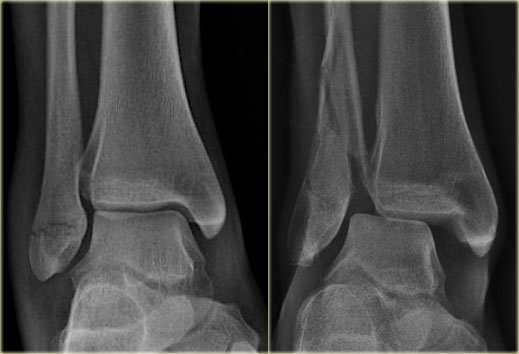Deltoid Ligament Repair
The deltoid ligament is a strong, broad, flat, triangular shaped ligament located on the medial (inside) of the ankle. It attaches the medial malleolus to the navicular, talus and calcaneus. This ligament is important in providing anterior to posterior stability as well as preventing lateral subluxation of the talus.

(Left) Xray showing a R ankle non-displaced lateral malleolus fracture distal to the joint line. The medial clear space is well maintained and the talus sits in proper position to the tibia.
(Right) Xray showing a R ankle lateral malleolus fracture above the joint line with widening of the medial clear space. Notice the lateral translation of the talus in relation to the tibia.
A disruption to the deltoid ligament requires a significant force to the ankle when the ankle is in eversion and dorsiflexion. This ligament is rarely injured in isolation and is often accompanied by a lateral malleolus fracture. As such, the examiner must have a high index of suspicion of this injury when examining the patient as to not be distracted by a fracture and fail to assess the deltoid ligament.
During examination, the patient presents with medial ankle pain on palpation. X-rays often show widening of the medial clear space between the medial malleolus and talus. A stress radiograph is often obtained to accentuate the medial clear space widening. A gap of over 4 mm with medial ankle pain over the deltoid ligament suggests a disruption of the deltoid ligament. There may also be an avulsion, or pulling away of a piece of bone, from the tip of the medial malleolus.
Treatment includes stabilizing the ankle joint by fixing the lateral malleolus. This provides a type of book-end effect keeping the talus in it’s appropriate position. Often times, this treatment allows for adequate approximation of the deltoid ligament, which will then scar down and heal with time. Your surgeon will perform stress views intra-operatively to ensure reduction of the ankle mortise. If the medial clear space remains wide after fibular fixation, this may indicate that the deltoid ligament is entrapped in the medial gutter and needs to be explored more thoroughly. Also, in high performance athletes or very active individuals, deltoid ligament repair may be indicated to facilitate a more robust fixation of the joint. In some patients who undergo fixation of the lateral malleolus, ankle instability may persist. If this case, if the deltoid ligament continues to demonstrate laxity, a repair may be recommended.
